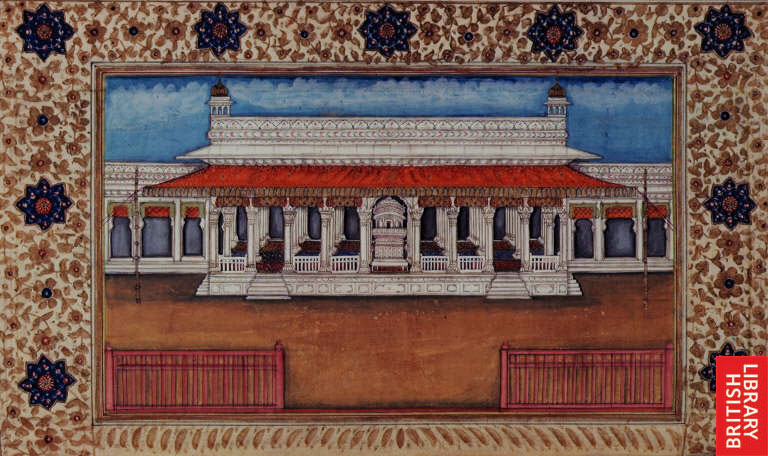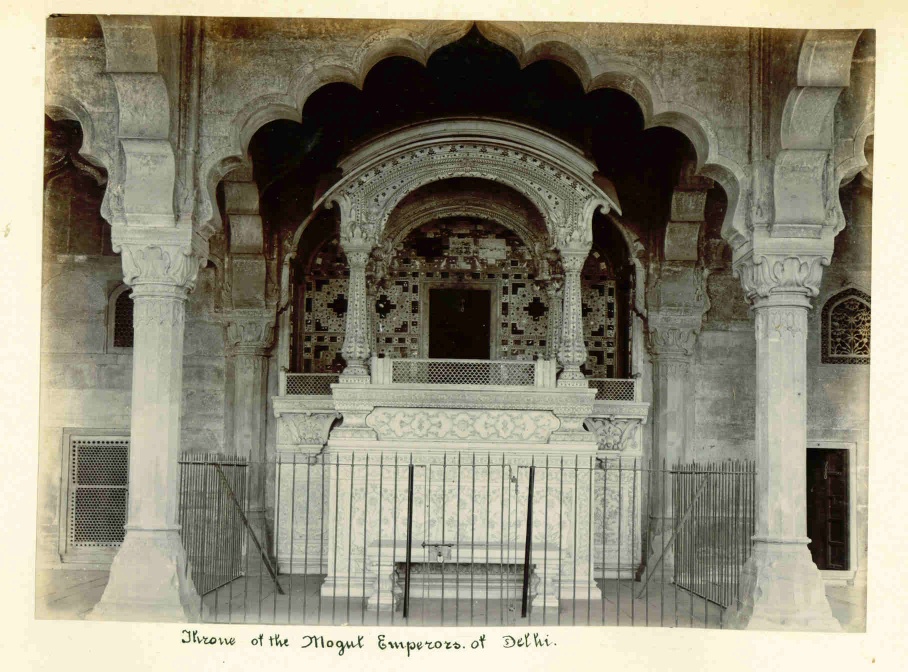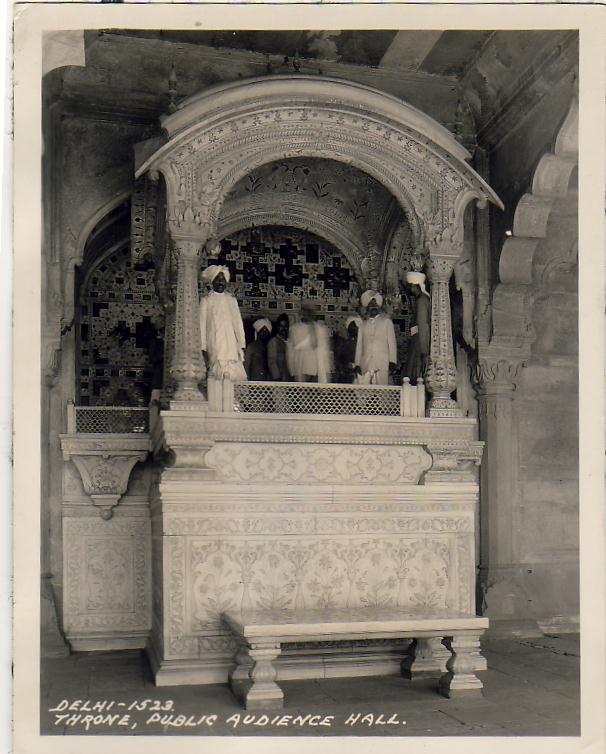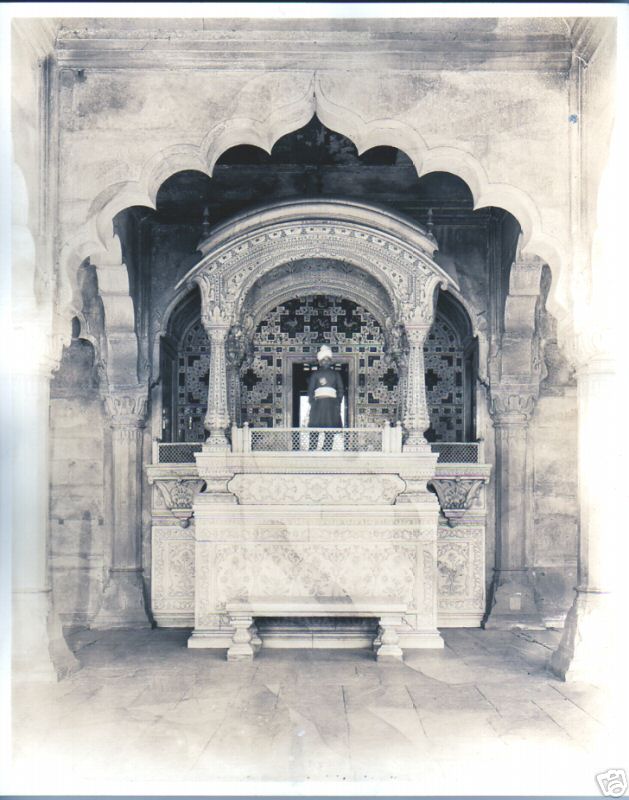

*Divan-i 'Amm; from the 'Amal-i Salih, by Muhammad Salih Kanbu, 1700's* (BL)

A silver print, c.1900
Source: ebay, Nov. 2007

A photo from c.1935
Source: ebay, May 2007

A visitor's photo of the throne, 1937
Source: ebay, Mar. 2007

The Divan-e 'Am in its setting, with visitors
Source: http://www.indiamike.com/photopost/showphoto.php/photo/10800
(downloaded Apr. 2006)
*The outer arches of the Divan'e 'Am, in a view from just outside and below the plinth*
Source: http://www.virtualtourist.com/m/e690/10c85e/
(downloaded Nov. 2002)

A closer look at the throne itself
Source: Courtesy of Rob McNamee, Columbia College, Jan. 2005
The court within which this splendid hall once stood was about 550 feet long and 300 feet wide; its walls contained arcaded apartments, in describing which Bernier remarks that they were not unlike the Palais Royal, but "with this difference, however, that the arcades of the Dewan 'Am have no buidings over them. Each arcade is separated by a wall, yet in such a manner that there is a small door to pass from one to the other." The rooms were two deep, raised about 3 1/2 feet from the ground, and were occupied by officers of the Court and Omrahs on duty. The rooms occupied by the latter were gorgeously got up on grand occasions; the pillars were covered with rich brocade, and the arches were hung with tapestry of silk and velvet of great beauty. The walls of this court were levelled with the ground after the Mutiny of 1857. Where the great hall now stands was the centre of the eastern wall of the court....
The hall itself, although robbed of its gilding and stucco, is yet a magnificent structure. It is built throughout of red sandstone, and stands on a plinth fully 4 feet from the ground, 80 feet long and 40 feet broad; from the platform to the top of the roof, not including the corner pavilions, the hall is about 30 feet high....
From the following description of the Diwan by Bernier, the reader will learn its history during the most glorious days of the Moghal Empire:
It is a great and stately hall, with many ranks of pillars high raised, very airy, open on three sides, looking to the Court, and having its pillars and ground painted and gilded. In the midst of the wall, which separates this hall from the seraglio, there is an opening, or a kind of great window, high and large, and so high that a man cannot reach to it from below with his hand. There it is where the King appears, seated upon his throne, having some of his sons on his sides and some eunuchs standing, some of whom drive away the flies with peacock's tails, others fan him with great fans, others stand there ready with great respect and humility for several services. Thence he sees beneath him all the Oomrahs, Rajas, and Ambassadors, who are also all of them standing upon a raised ground encompassed with silver rails, with their eyes downwards, and their hands crossing their stomach; somewhat further off he sees the mansebdars, or lesser Oomrahs, which are also all standing in the same posture and respect as the Oomrahs do; and somewhat further off, in the remaining part of the hall, and in the Court, he sees a great crowd of all sorts of people. For there it is where the King, every day about noon, giveth a general audience to all....During the hour that this audience ceremony continues, a certain number of the royal horses pass before the throne, that the King may see whether they are well used and in a proper condition. The elephants are covered with embroidered cloth; a couple of silver bells are suspended to the two ends of a massy silver chain placed over their back; and white cow-tails from Great Thibet, of great value, hang from the ears like immense whiskers. Two small elephants superbly caparisoned, walk close to these colossal creatures, like slaves appointed to their service. As if proud of his gorgeous attire and of the magnificence that surrounds him, every elephant moves with a solemn and dignified step; and when in front of the throne, the driver who is seated on his shoulder, pricks him with a pointed iron, animates and speaks to him, until the animal bends one knee, lifts his trunk on high and roars aloud, which the people consider as the elephant's mode of performing the taslim or usual reverence.
Other animals are next introduced; tame antelopes, kept for the purpose of fighting with each other; nilgaius, or grey oxen, that appear to me to be a species of elk; rhinoceroses; large Bengal buffaloes with prodigious horns which enable them to contend against lions or tigers; tame leopards, or panthers, employed in hunting antelopes; some of the fine sporting dogs from Usbec, of every kind, and each dog with a small red covering; lastly, every species of the birds of prey used in field sports for catching partridges, cranes, hares, and even, it is said, for hunting antelopes, on whom they pounce with violence, beating their heads and blinding them with their wings and claws.
Besides this procession of animals, the cavalry of one or two Oomrahs frequently pass in review before the King; the horsemen being better dressed than usual, the horses furnished with iron armous, and decorated with an endless variety of fantastic trappings.
The king takes pleasure also in having the blades of cutlasses tried on dead sheep brought before him, without the entrails and neatly bound up. Young Oomrahs, mansebdars, and gourzeberdars or mace-bearers exercise their skill, and put forth all their strength to cut through the four feet, which are fastened together, and the body of the sheep, at one blow.
But all these things are so many interludes to more serious matters. The king not only reviews his cavalry with peculiar attention, but there is not, since the war has been ended, a single cavalier or other soldier whom he has not inspected, and made himself personally acquainted with, increasing or reducing the pay of some and dismissing others from the service. All the petitions held up in the crowd assembled in the 'Am-Khas [=Divan-e Am] are brought to the king and read in his hearing; and the persons concerned being ordered to approach are examined by the monarch himself, who often redresses at the instant the wrongs of the aggrieved party. On another day of the week, he devotes two hours to hear, in private, the petitions of ten persons, selected from the lower orders, and presented to the king by a good and rich old man.
---Carr Stephen, Archaeology and Monumental Remains of Delhi (Author,
1876), pp. 225-27
== Indian Routes index == Indian Routes sitemap == Glossary == FWP's main page ==